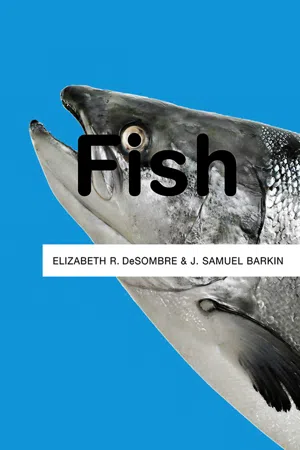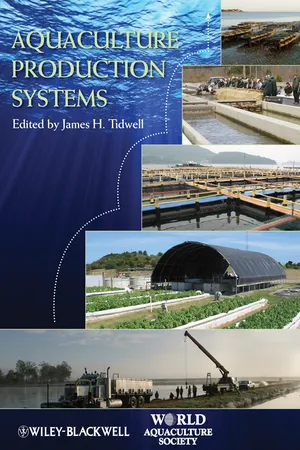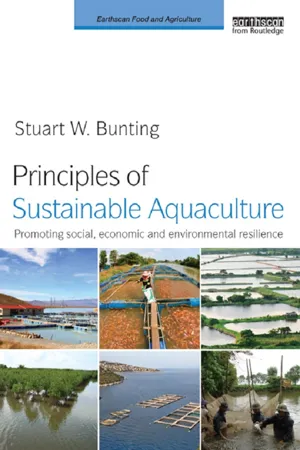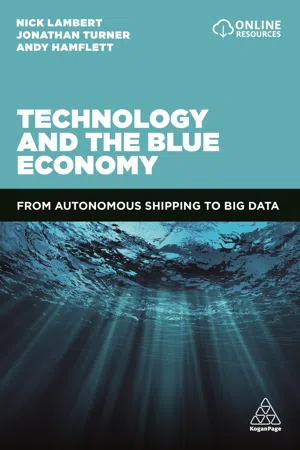Geography
Aquatic Food Production
Aquatic food production refers to the cultivation and harvesting of plants and animals in water environments such as oceans, rivers, and lakes. This includes activities like fish farming, aquaculture, and seaweed cultivation. Aquatic food production plays a significant role in providing food and livelihoods for people around the world, particularly in coastal and island communities.
Written by Perlego with AI-assistance
6 Key excerpts on "Aquatic Food Production"
Learn about this page
Index pages curate the most relevant extracts from our library of academic textbooks. They’ve been created using an in-house natural language model (NLM), each adding context and meaning to key research topics.
- eBook - ePub
- Elizabeth R. DeSombre, J. Samuel Barkin(Authors)
- 2013(Publication Date)
- Polity(Publisher)
CHAPTER FIVE AquacultureAquaculture is the technical term for fish farming. It is not a new phenomenon – on the contrary, it has been around for millennia. But it has expanded rapidly over the past few decades, both in the volume of fish farmed, and in the breadth of species farmed. The proportion of the world’s total seafood production accounted for by aquaculture increased from 13 percent to more than 35 percent in the period between 1990 and 2007.1 With the production of the global capture fishery having peaked at a little over 90 million tonnes a year, all of the growth in global production of seafood comes from the rapidly growing aquaculture sector. To the extent that global capture fisheries are at or near (or even beyond) their maximum sustainable yield, future growth in the supply of fish and other seafood can be expected to come exclusively from aquaculture.This sector is dominated by developing countries. China alone accounts for almost two-thirds of the global total aquaculture production as measured by weight (although under half by value), and the top five aquaculture producers globally – India, Vietnam, Indonesia, and Thailand follow China – are all developing countries (again by weight; measured by value Japan comes in fifth).2 A large majority of the world’s fish farming happens in Asia – almost nine-tenths by weight, and about three-quarters by value. The differences between weight and value are caused by the different kinds of aquaculture practiced in different places. Most of the fish farmed in Europe and North America are species that have a high price per weight, such as salmon and oysters, whereas much of the aquaculture in Asia is of lower-value species such as carp, grown with less capital for a more local market.The range of activities undertaken under the heading of aquaculture, and the range of scales on which it is practiced, is as broad as for capture fisheries. The range extends from small ponds in which a few herbivorous fish, such as carp or tilapia, are raised for local consumption, to massive industrial operations, involving millions of fish, that raise open-water predator species in pens at sea. Many aquaculture practices, including the small-scale fish pond example, are essentially benign. But as the scale of fish farming operations increases, and as it comes to involve species that are higher up the food chain, potential problems associated with aquaculture multiply. Unfortunately, it is the species that have the greatest value on the global market, such as salmon, shrimp, and tuna, that generate the greatest environmental challenges. These challenges include pollution from high concentrations of animals in confined spaces, the spread of disease among confined and in-bred populations, ecosystem disruptions, and threats to the biological integrity of the species in the wild. - eBook - ePub
Fisheries and Aquaculture
The Food Security of the Future
- Ágúst Einarsson, Ásta Dís Óladóttir(Authors)
- 2020(Publication Date)
- Academic Press(Publisher)
o The cultivation of marine products is the fastest growing food production sector in the world, with products from farmed fish now accounting for about 50% of the total consumption of fish in the world.Plants or plant products, such as soybean meal and plant-based oils, are being used in increasing quantities for the production of feed for fish, and plants have been used in the cultivation of carp species in China for thousands of years. Many of the plants that are cultivated in aquaculture are used for human consumption, while others are used for the production of feed for fish farms or for the cultivation of snails. But although seaweed can be wholesome and nutritious, it is used not only for feed, but also for various other products, such as medicinal and cosmetic products and food additives.Another role of aquaculture worth mentioning is the production of nonfood products such as shells and pearls, in addition to the medical and cosmetic products referred to earlier. Numerous accounts exist of large pearls being found by divers, but nowadays pearls are almost exclusively cultivated, particularly in the warm oceans of southern countries.In almost all the countries of the world aquaculture exists in some form, although by far the greatest production of farmed fish takes place in Asia. The total world aquaculture production in 2018 amounted to 114 million tons, and the value of the production at first sale was about 260 billion USD. Of the total production, about 82 million tons were aquatic animals, and about 32 million tons were aquatic algae. Of the 82 million tons of aquatic animals, 54 million tons were fin fish. The biggest aquaculture countries are China, Indonesia, India, Vietnam, and Bangladesh. China cultivates about 60% of the world production. Other Asian countries produce about 30%. Other continents, Africa, the Americas, Europe, and Oceania, account for only about a 10% share in the world production. - eBook - ePub
- James H. Tidwell(Author)
- 2012(Publication Date)
- Wiley-Blackwell(Publisher)
As we can see, aquaculture is no longer just a promising line of research or a promising theory. As Melba Reantso of FAO described it, “aquaculture is now known as the emerging new agriculture, the catalyst of the ‘blue revolution,’ the answer to the world's future fish supply, the fastest food producing sector, the future of fisheries.” Still, the task ahead is daunting. Aquaculture is expected to supply global seafood security, nutritional well-being, poverty reduction, and economic development by meeting all of these demands, but also accomplishing this with a minimum impact on the environment and maximum benefit to society. The remainder of this book will be devoted to helping the reader follow the development of aquaculture over time, truly understand and appreciate how the diverse systems used to raise these aquatic animals operate, and grasp the evolution of new systems and the changes that are sure to be wrought by climate change.1.7 References Annual Report on the United States Seafood Industry (ARUSSI; 2009) 16th Edition. Urner Barry, Tom's River, New Jersey.Cohen, J.H. (1995) How Many People Can The Earth Support? W.W. Norton & Co., New York.Coll, M., Libralato, S., Tudela, S., Palomera, I. & Pranovi, F. (2008) Ecosystem in the ocean. PlosOne 3(12):e3881.Diana, J.S. (2009) Aquaculture production and biodiversity conservation. BioScience 59(1):27–38.Duarte, C.M. et al. (2009) Will the oceans help feed humanity? BioScience 59(11):967–76.FAO (2001) State of the World Fisheries and Aquaculture . FAO, Rome.FAO (2007) State of the World Fisheries and Aquaculture . FAO, Rome.FAO (2009) State of the World Fisheries and Aquaculture . FAO, Rome.FAO (2010) State of the World Fisheries and Aquaculture . FAO, Rome.Lowther, A. (2007) Highlights from the FAO database on aquaculture statistics. FAO Aquaculture Newsletter 38:20–1.Mace, R.M. (1997) Developing and sustaining world fisheries resources: The state of the science and management. In Second World Fisheries Congress - eBook - ePub
Sustainable Blue Revolution in India
Way Forward
- Latha Shenoy, Shridhar Rajpathak(Authors)
- 2021(Publication Date)
- CRC Press(Publisher)
CHAPTER 4 AQUACULTUREIntroduction
Fish is the most important source of animal protein for the human population, it is rich in protein and essential amino acids. It is also a good source of calcium, vitamin A, B12 and omega-3 fatty acids. People irrespective of age who do not get enough nutrients from cereal-based diets, would be benefited from the inclusion of fish in the diet. Aquaculture not only supplies dietary essentials for human consumption, but provides excellent opportunities for employment and income generation, especially in the more economically backward rural areas. Sixty million people are directly engaged, part time or full time, in primary production of fish, either by fishing or in aquaculture, supporting the livelihoods of 10-12% of world population (FAO, 2016 ). Aquaculture currently accounts for over 50% of the global food fish consumption (FAO, 2016 ). Aquaculture in India has evolved as a viable farming practice over last three decades with considerable diversification in terms of species and systems, and has been showing an impressive annual growth rate of 6-7% (FAO 2019 ).Aquaculture is currently one of the fastest growing food production systems in the world. Most of the global aquaculture output is produced in developing countries and significantly in low-income food-deficit countries. As defined by the United Nations Food and Agriculture Organization (FAO), aquaculture is the “farming of aquatic organisms including fish, mollusks, crustaceans and aquatic plants.” With stagnating yields from many capture fisheries and increasing demand for fish and fishery products, expectations for aquaculture to increase its contribution to the world’s production of aquatic food are very high, and there is also hope that aquaculture will continue to strengthen its role in contributing to food security and poverty alleviation in many developing countries. However, it is also recognized that aquaculture encompasses a very wide range of different aquatic farming practices with regard to species (including seaweeds, molluscs, crustaceans, fish and other aquatic species groups), environments and systems utilized, with very distinct resource use patterns involved, offering a wide range of options for diversification of avenues for enhanced food production and income generation in many rural and peri-urban areas. - eBook - ePub
Principles of Sustainable Aquaculture
Promoting Social, Economic and Environmental Resilience
- Stuart W. Bunting(Author)
- 2013(Publication Date)
- Routledge(Publisher)
Recirculating aquaculture systems (RAS) integrating fish and plant culture have been central to several initiatives in Europe and North America to facilitate urban regeneration, through combining local food production, employment, recreation and education. Life cycles of cultured organisms, ecosystem process and functions involved in maintaining a healthy environment and principles of integrated production provide important insights for students concerning ecology and water and nutrient cycles. Broader environmental and socioeconomic considerations and concerns are often invoked when proposing urban and peri-urban aquaculture developments to planners and investors. Local food production where consumers can witness the means of production and perhaps discuss this with producers, and where transport costs are minimised, is often espoused as inherently more desirable than centrally processing and distributing or importing products. Production in intensively managed RAS systems is, however, energy hungry, whilst alternative but responsible aquaculture systems in developing countries supplying export markets may actually convey significant socio-economic benefits to local communities.Several pilot-scale urban aquaculture operations have been established in North America, primarily for education and community development, for example, recirculating aquaculture systems in Boston Harbor, Massachusetts (Goudey and Moran, 2005) and Brooklyn, New York (Schreibman and Zarnoch, 2005) and as part of the urban aquaculture education programme, New Haven, Connecticut (Roy, 2005). Aims cited for the Massachusetts Institute of Technology (MIT) Sea Grant programme in Boston Harbour by Goudey and Moran (2005) encompassed culture protocols for commercial marine finfish species, evaluating growth and environmental impacts, demonstration of recirculating aquaculture and outreach and education activities. Unfortunately the authors noted that water quality problems, a legacy of contaminated sediments associated with former naval dockyards and increasing competition for property with harbour access constitute major barriers to commercial aquaculture development. - eBook - ePub
Technology and the Blue Economy
From Autonomous Shipping to Big Data
- Nick Lambert, Jonathan Turner, Andy Hamflett(Authors)
- 2019(Publication Date)
- Kogan Page(Publisher)
07Aquaculture
Meeting the world’s food needs in an environmentally sound manner
The tipping point came in 2009. That was the year when it was revealed that the majority of fish finding its way onto the world’s plates came from controlled farm environments, rather than being caught in the wild. Aquaculture production nearly tripled in volume between 1995 and 2007, and has continued at pace ever since. The authors of the report highlighted the public’s demand for the omega-3 fatty acids found in oily fish (believed to be good for the heart) as one of the key drivers behind this meteoric rise of farmed fish (Livescience.com , 2009), but this also aligns to the growing basic need for fish as a food source, the background to which we explore in greater detail in Chapter 10 , which focuses on sustainable fisheries. However, aquaculture deserves greater investigation, due to its growth prospects and the particular challenges and opportunities that it presents.By 2016, production from aquaculture had reached 80 million tonnes, providing 53 per cent of all fish consumed by humans as food (Food and Agriculture Organization (FAO), 2018) and the World Bank estimates that the size and scale of the aquaculture market will continue to grow until by 2030 it will account for 62 per cent of all the seafood we consume (World Bank, 2014). This is not only important news for the Blue Economy; the FAO has also pointed out that aquaculture continues to outpace every other food production sector, growing as it has at an annual compound growth rate of nearly 6 per cent since 2010 (US Soybean Export Council, 2018); in 2016 alone, the aquaculture sector increases production by some 4 million tonnes year on year. Additionally, in its comprehensive 2016 Ocean economy report, the Organisation for Economic Co-operation and Development (OECD) highlighted the industrial marine aquaculture market as one of the key prospects for high long-term growth, with employment within the sector predicted to increase by over 150 per cent by 2030.





